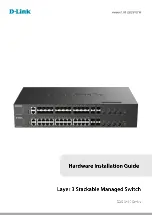
NS3503-16P-4C User Manual
124
Default Spanning-Tree Configuration
Feature
Default Value
Enable state
STP disabled for all ports
Port priority
128
Port cost
0
Bridge Priority
32,768
User-Changeable STA Parameters
The Switch’s factory default setting should cover the majority of installations. However, it is advisable to
keep the default settings as set at the factory; unless, it is absolutely necessary. The user changeable
parameters in the Switch are as follows:
Priority
– A Priority for the switch can be set from 0 to 65535. 0 is equal to the highest Priority.
Hello Time
– The Hello Time can be from 1 to 10 seconds. This is the interval between two
transmissions of BPDU packets sent by the Root Bridge to tell all other Switches that it is indeed the
Root Bridge. If you set a Hello Time for your Switch, and it is not the Root Bridge, the set Hello Time will
be used if and when your Switch becomes the Root Bridge.
Note
: The Hello Time cannot be longer than the Max. Age. Otherwise, a configuration error will
occur.
Max. Age
– The Max Age can be from 6 to 40 seconds. At the end of the Max Age, if a BPDU has still
not been received from the Root Bridge, your Switch will start sending its own BPDU to all other
Switches for permission to become the Root Bridge. If it turns out that your Switch has the lowest Bridge
Identifier, it will become the Root Bridge.
Forward Delay Timer
– The Forward Delay can be from 4 to 30 seconds. This is the time any port on
the
Switch spends in the listening state while moving from the blocking state to the forwarding state.
Note
: Observe the following formulas when setting the above parameters:
Max. Age _ 2 x (Forward Delay - 1 second)
Max. Age _ 2 x (Hello Time + 1 second)
Port Priority
– A Port Priority can be from 0 to 240. The lower the number, the greater the probability the
port will be chosen as the Root Port.
Port Cost
– A Port Cost can be set from 0 to 200000000. The lower the number, the greater the
probability the port will be chosen to forward packets.
3. Illustration of STP
A simple illustration of three switches connected in a loop is depicted in the below diagram. In this
example, you can anticipate some major network problems if the STP assistance is not applied.
If switch A broadcasts a packet to switch B, switch B will broadcast it to switch C, and switch C will
broadcast it to back to switch A and so on. The broadcast packet will be passed indefinitely in a loop,
potentially causing a network failure. In this example, STP breaks the loop by blocking the connection
Содержание NS3503-16P-4C
Страница 1: ...NS3503 16P 4C User Manual P N 1073221 REV A ISS 08SEP16 ...
Страница 143: ...141 NS3503 16P 4C User Manual Figure 4 7 3 Multicast Service Figure 4 7 4 Multicast Flooding ...
Страница 302: ...NS3503 16P 4C User Manual 300 The screen in Figure 4 16 5 appears Figure 4 16 5 PoE Schedule Screenshot ...
















































